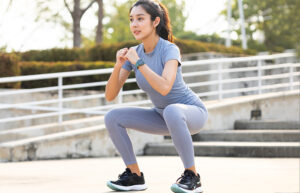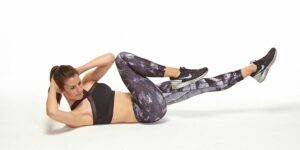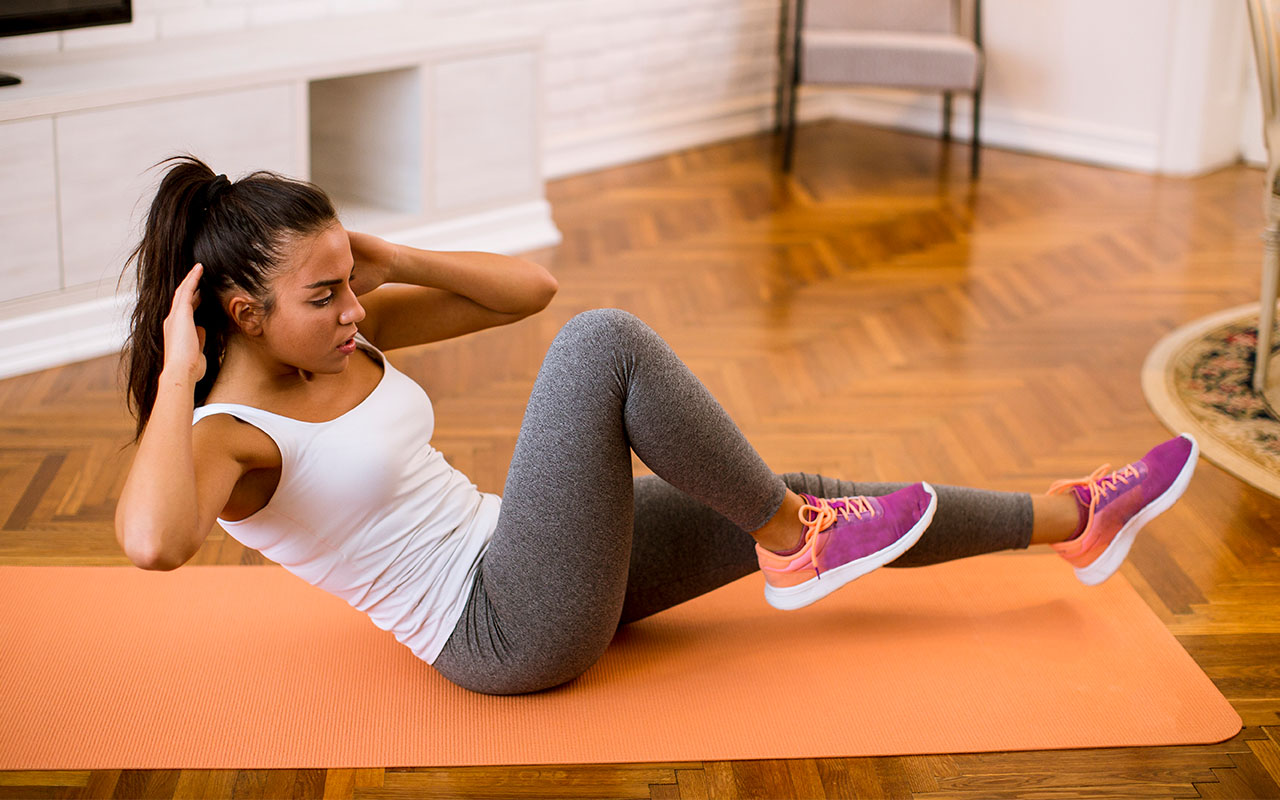12 Best Benefits of Sit-Ups
12 Best Benefits of Sit-Ups, Even when sit-ups are part of a regular exercise routine, muscle development can slow down after some time. Your abdominal muscles can get used to a particular exercise, and as a result, you’ll need to find new ways to challenge these muscles.
Switching to a weighted sit-up is a simple way to change up your workout and add a new stimulus. After many years of experience as a seasoned body fitness trainer, We have come to realize that sit-ups top the list of exercises that barely require any skills.
It breaks our heart when we see people shying away from sit-ups for alleged lack of a personal trainer, yet these exercises can be accomplished anywhere. This includes at home or even during work breaks. Besides, they don’t have time restrictions and can be done in the morning just after waking up, in the evening, or even just before bed.
When done diligently, the benefits of sit ups extend well beyond facilitating muscle growth and enhanced tonality. In fact, statistics depict that sit-ups are capable of creating a synergistic environment within your body. This allows your organs and muscles to harmonize in reaching a point of prime optimization. What beats an effortless exercise that requires minimal training, time, or commitment? Read on to realize as I have, the major benefits to be derived from doing sit-ups on a regular basis.
12 Benefits of Sit-Ups
1. Improved Muscle Mass
Sit-ups build muscle strength in the abdominal and hip muscles. Sit-up performance may be a useful indicator of muscle loss. According to research from 2016, older women who were able to do sit-ups were less likely to have sarcopenia, which is the natural loss of muscle due to aging.
Contrary to the prevailing misconception, sit-ups do not solely work on your abs. In fact, these exercises create variable movements that include the motion of lifting your whole abdominal weight. This enables them to work out quite a number of muscle groups as explained below.
- Leg muscles: The muscles in your legs benefit greatly from regular sit-ups; this is crucial for improved mobility.
- Back muscles: Sit-ups are especially ideal for working out your back muscles, which are perceived as core muscle groups. These are required in your everyday movements, including lifting things.
- Stabilizer muscles: These are tasked with connecting a wide range of muscle groups, which facilitates your ability to use them in a coordinated manner. The stabilizer muscles are usually thoroughly worked when you’re doing sit-ups.
- Hip flexors: These are responsible for connecting the stabilizers, which in turn, facilitates your ability to bend and rotate.
2. Best for the Core
Core strength is one of the biggest motivators for doing sit-ups. By strengthening, tightening, and toning your core, you reduce your risk of back pain and injuries. You’ll be able to move with greater ease as you complete your daily routine and participate in athletic activities.
Core muscles are crucial components for kinesthetic accomplishments. These muscles are largely responsible for such passive attributes as posture. They are divided into the following groups.
- The pelvic muscles, which are vital components for balance
- Abdominal muscles, which provide the required support for your body weight and motion
- Hip muscles and joints, which come in handy when bending over and moving. These muscles should be preserved, lest you develop such conditions as osteoarthritis.
- The lower back muscles that play a crucial role in your lifting capacity. These muscles are susceptible to injury, which can bring forth catastrophic consequences. It is, therefore, imperative that you maintain the strength in your back.
By improving the strength of your core muscles, sit-ups not only facilitate your ability to move but also improve the functionality of your organs.
Bad posture and weak core muscles could easily lead to improperly positioned organs, some of which could even lose their function.
3. Improve Posture
Building a strong, solid core makes it easier to keep your hips, spine, and shoulders in alignment, which helps to improve posture. Benefits of good posture include less pain and tension, increased energy levels, and improved breathing.
Posture is considered very crucial due to a number of reasons:
- Bad posture is actually detrimental to your health; it can cause misalignment of your spine or neck problems. Improper posture could easily lead to long-lasting damage to your body as it means that your muscles and bones are not held appropriately.
- A good posture not only protects you from injuries, it also ensures your preparedness against dangerous blows.
By ensuring everyday growth of your core muscles, regular sit-ups naturally improve your posture. Stronger and more toned muscles compel your body to compose itself with enhanced power while being more erect and natural.
Besides, the omission of weight or extra equipment in your exercises ensures that you don’t end up with disproportionate gains.
4. Improved Stability and Balance
A strong core helps to keep your body balanced and stable as you move throughout your daily and athletic activities. They help your pelvis, lower back, and hip muscles to work together with your abdominal muscles. Good balance makes you less likely to fall and injure yourself.
By improving your overall stability and balance, sit-ups can render your day-to-day life a whole lot easier. For instance, these exercise leads to enhanced flexibility, ensuring that you are sufficiently elastic and in a better position to perform movements you otherwise couldn’t.
Sit-ups also allow your legs to develop incredible strength that could enable you to walk and run easier.
This implies that you won’t lose your ability to perform activities that rely on your core strength. Studies reveal that losing your balance or ability to move in your old age can be blamed on degrading core strength.

5. Reduce Injury Risks
While it’s a common belief that sit-ups can cause injuries, a 2010 study of U.S. Army soldiers found that the inclusion or exclusion of sit-ups in an exercise program yielded similar results in terms of musculoskeletal injuries.
There are a few ways that sit-ups can prevent you from sustaining injuries. Some of these include
- Improved Flexibility: Sit-ups will improve your flexibility, especially at your back and hip region. Lack of flexibility is caused by tight muscles, which can be flexed if you exercise them regularly.
- Eliminating Back Pain: Having strong core muscles can help to prevent the development of back pain. When you establish your strength in the rear area, you will avoid putting too much strain on your back. This will help to heal minor existing problems and prevent getting others. Exercising your muscles gives you control over them, which means that you will avoid painful spasms.
- Enhanced Core Strength: A person with a strong core is less likely to sustain injuries by lost balance or a blunt force. You are less likely to strain when doing normal work. For the elderly, there are reduced chances of losing balance.
6. Increase Your Cardiovascular Endurance
The heart is among the most vital muscles in your body. Regular exercises, including sit ups can strengthen it a great deal.
Sit ups can also adjust it to do harder jobs; this is manifested by the way it pumps when you are working out or doing difficult work.
Basically, when you have a strong heart, you have a better cardiovascular endurance, which proves how well your lungs and heart are working to supply oxygen to your muscles and other organs in your body.
7. Diaphragm Strengthening
Sit-ups are a great way to practice diaphragmatic breathing. Sit-ups cause compression of the abdomen, which can have a positive effect on your diaphragm. A strong, healthy diaphragm can improve your breathing patterns, alleviate stress, and enhance athletic endurance.
A small 2010Trusted Source study looked at the effects of several abdominal exercises in terms of diaphragmatic pressure. Sit-ups were found to be beneficial in strengthening the diaphragm and improving respiratory function. Larger, more in-depth studies are needed to expand upon these findings.
8. Requires No Special Equipment
Most people get fooled into thinking that since sit-ups require no specialized fitness equipment, they are not capable of chiseling out a six-pack on your torso. In sharp contrast, it has been shown that using fancy workout gear doesn’t necessarily give an advantage over your simple sit-up or crunch.
This emphasizes the fact that you don’t need to visit the gym to do sit-ups; you can comfortably accomplish this in the privacy and comfort of your home.
9. Easy Modified
No single exercise can beat sit-ups in its ability to be modified to suit variable workout requirements. Instead of having different workout routines that cater to specific areas of your body, you can fulfill your needs by doing simple, modified sit-ups.
- You could place your legs up on a bench, wall or bed while doing sit-ups. This would require you to do a lot more lifting before you can accomplish a single rep.
- You may opt to hold weights on your chest for the purposes of complementing the effort you are required to exert, hence more gains
- It’s possible to alter sit-ups to enhance or decrease their intensity
There are variable sit-ups, each of which targets different sets of core muscles. Switching up on these varieties is important in ensuring that your body gets maximum improvement.

10. Improve Metabolism
Sit-ups go beyond building your body strength; as you build your muscles, you end up consuming a lot of calories.
This means that you continue burning calories even after you are done with the exercises. Doing sit-ups is very helpful for your body’s metabolism, which is especially true for people who are looking to lose weight.
People who take unhealthy meals have the tendency of assuming that eating a lot of food is a bad habit. If you eat a lot of wholesome healthy food and do sit-ups regularly, you will be astonished by the benefits you reap.
11. Athletics Performance
Strong core muscles are linked to improved muscular strength and endurance in athletes. A strong core gives you proper posture, stability, and form, allowing you to perform at higher levels during any sport or physical activity. Plus, you’ll be less likely to experience fatigue.
12. Improved Saving
By creating a workout schedule based on the weight of your body, you can end up saving a lot of money. A lot of people spend too much money on workout equipment and monthly gym fees.
All these will not be necessary for you if you simply want to gain endurance, grow your muscle mass, or build core strength.
Contrary to popular belief, sit-up exercises do not just provide a great way of growing muscle mass; they are also effective when it comes to building core strength and endurance.
To achieve this, you don’t need to spend a penny; no specialized equipment or trainer is required.
Conclusion
Sit-ups are the exercise that can be correctly considered a full-body workout. This is extremely impressive in the face of the fact that most people spend substantial amounts of money annually to go to gyms, yet there is a single exercise that can work out the entire body.
Sit-ups are useful in building and maintaining a strong core that benefits all types of movement. They are a great addition to a total-body workout routine that includes aerobic activity and strength training.
It’s best to engage in at least 150 minutes of moderate aerobic activity or 75 minutes of vigorous aerobic activity per week, along with at least two days of strength training. Consider joining a yoga, Pilates, or core conditioning class to improve strength, balance, and flexibility.
To lose weight, increase your daily activity, reduce the amount of time you spend sitting, and follow a healthy diet. Keep in mind, it’s best to focus on your core strength instead of the appearance of your midsection.
Concentrate on working out your whole body, and up the intensity and duration to achieve your desired results.
Besides, deriving the many benefits of sit ups is very easy as the exercises can be accomplished at the comfort of your home with little or no training. You can do anywhere, anytime. No workout is greater for travel especially when you don’t have access to the gym.


Хризантемные букеты с доставкой по Москве без дополнительных затрат — это отличное решение для всех, кто хочет порадовать близких. Эти цветы славятся своей необычной формой и широкой палитрой оттенков. С их помощью можно создать изысканные композиции.
[url=https://hrizantemymsk.ru/]Букеты из хризантем с бесплатной доставкой по Москве[/url]
Мы предлагаем разнообразные варианты цветочных композиций. Каждый букет оформляется с особой тщательностью. Мы понимаем, как важен момент дарения.
Вы можете заказать букет онлайн и выбрать время доставки. Мы гарантируем, что ваш букет будет доставлен в срок. Наши курьеры заботятся о том, чтобы цветы прибыли в идеальном состоянии.
Выбирая хризантемные букеты, вы дарите себе и близким радость и красоту. Не упустите возможность порадовать своих близких цветами. Свяжитесь с нами, и мы с удовольствием поможем вам выбрать лучший букет.
Как оформить разрешение на работу, необходимый этап, нужно изучить.
Разрешение на работу за границей: основные моменты, полезная информация.
Разрешение на работу: основные требования, разбираем.
Подробности о продлении разрешения на работу, рекомендации.
Разрешение на работу для студентов, необходимые документы.
Как избежать ошибок при получении разрешения на работу, полезная информация.
Сравнение разрешений на работу в разных странах, разберитесь.
Перечень документов для разрешения на работу, ознакомьтесь документы.
Как получить разрешение на работу без отказа, важные советы.
Что нужно знать о своих правах при получении разрешения на работу, подробности.
Сроки получения разрешения на работу, все о сроках.
Разрешение на работу для фрилансеров, рекомендации.
Где узнать о готовности разрешения на работу, пошаговая инструкция.
Разрешение на работу для родителей-одиночек, пошаговый план.
Интервью при получении разрешения на работу, как пройти успешно.
Разрешение на работу и налоги, разъяснения.
Разрешение на работу для людей с инвалидностью, рекомендации.
Оплата услуг по получению разрешения на работу, финансовые аспекты.
Как переехать за границу с разрешением на работу, необходимые шаги.
Особенности получения разрешения на работу в кризис, что учитывать.
разрешение на работу иностранным гражданам [url=oformleniernr.ru#разрешение-на-работу-иностранным-гражданам]oformleniernr.ru[/url] .
Гортензии в букете с бесплатной доставкой прямо в Москве — это отличное решение для тех, кто хочет удивить своих близких. Именно гортензии привносят в подарок нежность и красоту, идеально подходя для любого случая.
[url=https://gortenziimsk.ru/]Букет гортензий с бесплатной доставкой в Москве[/url].
Вы можете заказать доставку букета гортензий в любое время и в любое место в Москве. Каждый букет гортензий создается мастерами флористики с любовью и вниманием.
Гортензии — это цветы, которые легко сочетаются с другими растениями. Поэтому букет гортензий можно использовать не только для праздников, но и как дополнение к интерьеру.
Не забывайте, что красивые цветы — это отличный способ выразить свои чувства. Заказать букет гортензий с бесплатной доставкой можно всего лишь в несколько кликов.
[…] Benefits of Doing Sit Ups […]
Dice games are such a fascinating blend of luck & strategy! Thinking about classic games of chance, I stumbled across bbjl link – seems like a cool modern take on that heritage, especially with the app access! Fun to explore new platforms.
srqlytzmiymnmkrxmgqrqjptidvqsl
It’s easy to get carried away with online games, so setting limits is key! Seeing platforms like phwin777 legit emphasize quick access & easy deposits is a bit concerning – responsible play first, always! Let’s prioritize wellbeing. 😊
https://t.me/s/Online_1_xbet/1080
https://t.me/s/Official_1xbet_1xbet/1767
https://t.me/s/Official_1xbet_1xbet/1780
https://t.me/s/Official_1xbet_1xbet/1822
https://t.me/Official_1xbet_1xbet/1696
https://t.me/s/Official_1xbet_1xbet/1606
https://t.me/Official_1xbet_1xbet/1789
https://t.me/s/Official_1xbet_1xbet/1854
https://t.me/s/Official_1xbet_1xbet/1724
https://t.me/Official_1xbet_1xbet/1600
https://t.me/s/Official_1xbet_1xbet/1651
https://t.me/s/Official_1xbet_1xbet/1711
https://t.me/Official_1xbet_1xbet/1631
https://t.me/Official_1xbet_1xbet/1763
https://t.me/s/Official_1xbet_1xbet/1739
https://t.me/Official_1xbet_1xbet/1616
https://t.me/s/Official_1xbet_1xbet/1713
https://t.me/Official_1xbet_1xbet/1750
https://t.me/s/Official_1xbet_1xbet/1693
https://t.me/Official_1xbet_1xbet/1776
https://t.me/Official_1xbet_1xbet/1727
https://t.me/s/Official_1xbet_1xbet/1656
https://t.me/s/Official_1xbet_1xbet/1598
https://t.me/s/Official_1xbet_1xbet/1725
https://t.me/s/Official_1xbet_1xbet/1760
https://t.me/s/Official_1xbet_1xbet/1648
https://t.me/Official_1xbet_1xbet/1639
https://t.me/s/Official_1xbet_1xbet/1710
https://t.me/Official_1xbet_1xbet/1597
https://t.me/Official_1xbet_1xbet/1710
https://t.me/Official_1xbet_1xbet/1654
https://t.me/s/Official_1xbet_1xbet/1758
https://t.me/s/Official_1xbet_1xbet/1782
https://t.me/Official_1xbet_1xbet/1837
https://t.me/s/Official_1xbet_1xbet/1691
https://t.me/Official_1xbet_1xbet/1636
https://t.me/Official_1xbet_1xbet/1779
https://t.me/s/Official_1xbet_1xbet/1645
https://t.me/s/Official_1xbet_1xbet/1765
https://t.me/Official_1xbet_1xbet/1769
https://t.me/Official_1xbet_1xbet/1774
https://t.me/s/Official_1xbet_1xbet/1621
https://t.me/Official_1xbet_1xbet/1693
https://t.me/Official_1xbet_1xbet/1610
https://t.me/Official_1xbet_1xbet/1764
https://t.me/s/Official_1xbet_1xbet/1647
https://t.me/Official_1xbet_1xbet/1687
https://t.me/s/Official_1xbet_1xbet/1826
https://t.me/s/Official_1xbet_1xbet/1830
https://t.me/s/Official_1xbet_1xbet/1766
https://t.me/s/Official_1xbet_1xbet/1795
https://t.me/s/Official_1xbet_1xbet/1620
https://t.me/s/Official_1xbet_1xbet/1847
https://t.me/s/Official_1xbet_1xbet/1808
https://t.me/Official_1xbet_1xbet/1721
https://t.me/s/Official_1xbet_1xbet/1824
https://t.me/s/Official_1xbet_1xbet/1769
https://t.me/s/Official_1xbet_1xbet/1638
https://t.me/s/Official_1xbet_1xbet/1608
https://t.me/Official_1xbet_1xbet/1651
https://t.me/s/Official_1xbet_1xbet/1632
https://t.me/Official_1xbet_1xbet/1635
https://t.me/Official_1xbet_1xbet/1806
https://t.me/s/Official_1xbet_1xbet/1624
https://t.me/s/Official_1xbet_1xbet/1821
https://t.me/Official_1xbet_1xbet/1790
https://t.me/reiting_top10_casino/5
https://t.me/s/reiting_top10_casino/2
https://t.me/s/reiting_top10_casino/5
https://t.me/reiting_top10_casino
https://t.me/reiting_top10_casino/9
https://t.me/reiting_top10_casino/7
https://t.me/s/reiting_top10_casino/4
https://t.me/reiting_top10_casino/3
https://t.me/reiting_top10_casino/6
https://t.me/s/reiting_top10_casino/7
https://t.me/reiting_top10_casino/8
https://t.me/s/Gaming_1xbet
https://t.me/s/jw_1xbet/447
https://t.me/jw_1xbet/606
https://t.me/jw_1xbet/902
https://t.me/jw_1xbet/15
https://t.me/s/jw_1xbet/648
https://t.me/bs_1Win/553
https://t.me/bs_1Win/639
https://t.me/bs_1Win/950
https://t.me/bs_1Win/817
https://t.me/bs_1Win/790
https://t.me/bs_1Win/1040
https://t.me/bs_1Win/1042
https://t.me/bs_1Win/1147
https://t.me/s/bs_1Win/1192
https://t.me/bs_1Win/892
https://t.me/bs_1Win/373
https://t.me/bs_1Win/382
https://t.me/bs_1Win/1088
https://t.me/Official_mellstroy_casino/18
https://t.me/s/Official_mellstroy_casino/29
https://t.me/Official_mellstroy_casino/54
https://t.me/Official_mellstroy_casino/50
https://t.me/Official_mellstroy_casino/49
https://t.me/Official_mellstroy_casino/58
https://t.me/s/Official_mellstroy_casino/15
https://t.me/Official_mellstroy_casino/35
https://t.me/s/Official_mellstroy_casino/41
https://t.me/Official_mellstroy_casino/21
https://t.me/s/Official_mellstroy_casino/21
https://t.me/ud_Vodka/45
https://t.me/ud_Booi/61
https://t.me/s/ud_Sol/55
https://t.me/ud_Daddy/52
https://t.me/s/ud_Vodka/54
https://t.me/s/ud_PlayFortuna/46
https://t.me/s/ud_CatCasino/58
https://t.me/ud_Rox/49
https://t.me/ud_MostBet/57
https://t.me/ud_Izzi/63
https://t.me/s/ud_Kometa/59
https://t.me/s/ud_Sol/64
https://t.me/s/ud_Kent/51
https://t.me/ud_Jet/59
https://t.me/ud_Gizbo/52
https://t.me/ud_1xbet/54
https://t.me/s/ud_MrBit/60
https://t.me/ud_Jet/58
https://t.me/s/ud_Pokerdom/56
https://t.me/s/ud_Pinco/52
https://t.me/s/ud_1xSlots/53
https://t.me/ud_1xSlots/48
https://t.me/s/ud_JoyCasino/28
https://t.me/ud_CatCasino/38
https://t.me/s/ud_Casino_X/40
https://t.me/s/Ud_GiZbo
https://t.me/s/Official_mellstroy_casino
https://t.me/s/UD_lex
https://t.me/s/ud_MarTin
https://t.me/s/UD_LegzO
https://t.me/s/uD_stArda
https://t.me/s/ud_poKERdoM
https://t.me/s/UD_PlAYfoRtuNA
https://t.me/s/ud_JoycaSino
https://t.me/s/Ud_IZZI
https://t.me/s/UD_ROX
https://t.me/s/uD_1XBET
https://t.me/s/ke_Flagman
https://t.me/s/kef_Lex
https://t.me/s/ke_JoyCasino
https://t.me/s/ke_PlayFortuna
https://t.me/s/ke_Gama
https://t.me/s/ke_Pin_Up
https://t.me/s/ke_CatCasino
https://t.me/s/ke_MrBit
https://t.me/s/official_Riobet_ed
https://t.me/s/official_Vulkan_es
https://t.me/s/Sol_egs/8
https://t.me/Flagman_egs/9
https://t.me/GGBet_egs/8
https://t.me/s/GGBet_egs/11
https://t.me/Kometa_egs/4
https://t.me/ah_1xbet/7
https://t.me/s/ah_1xbet/18
https://t.me/s/ah_1xbet/10
https://t.me/s/ah_1xbet/16
https://t.me/ah_1xbet/9
https://t.me/ah_1xbet/11
https://t.me/ah_1xbet/18
https://t.me/s/ah_1xbet/12
https://t.me/s/ah_1xbet/19
https://t.me/s/ah_1xbet/9
https://t.me/s/Best_rating_casino
https://t.me/topcasino_rus/
https://t.me/kazino_bez_filtrov
https://t.me/s/kazino_bez_filtrov
https://t.me/s/rq_1xbet/1304
https://t.me/s/rq_1xbet/1438